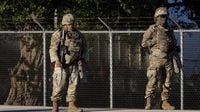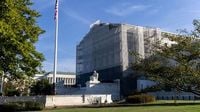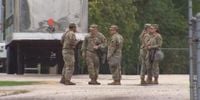The legal and political battle over President Donald Trump’s attempt to deploy National Guard troops in Chicago reached a fever pitch this week, as the administration filed an emergency appeal to the Supreme Court on October 17, 2025. The move marks the first time that a block on Trump’s troop deployments in a major U.S. city has landed before the nation’s highest court, setting up a high-stakes showdown over the limits of presidential power, federal authority, and the rights of states to govern themselves.
At the heart of the controversy is Trump’s effort to federalize Illinois and Texas National Guard troops and send them into Chicago, a city that has become a flashpoint amid escalating protests against aggressive immigration enforcement. According to Axios, the Trump administration argued that the deployment was necessary to protect federal officials and property, claiming that federal agents “have been threatened and assaulted, attacked in a harrowing pre-planned ambush involving many assailants.” Solicitor General D. John Sauer, representing the administration, told the Supreme Court that “federal agents are forced to desperately scramble to protect themselves and federal property, allocating resources away from their law-enforcement mission to conduct protective operations instead.”
But local and state officials in Illinois paint a very different picture. Illinois Governor JB Pritzker, in a statement posted to X (formerly Twitter), declared, “Militarizing our communities against their will is not only un-American but also leads us down a dangerous path for our democracy.” He further accused the federal government of using “propaganda” and excessive force, saying, “Anyone claiming that there is a rebellion or insurrection in Chicago is not telling the truth.” Chicago Mayor Brandon Johnson echoed this sentiment, vowing, “Regardless of what the Supreme Court decides, we will continue to fight to end the war on Chicago.” Johnson insisted that “Chicago does not need or want National Guard troops on the streets of our city.”
The legal wrangling began earlier in October, when U.S. District Court Judge April Perry, an appointee of President Joe Biden, issued an order temporarily blocking the deployment of the Guard. Perry found “no credible evidence that there is a danger of rebellion in the state of Illinois,” and criticized what she described as a “troubling trend of defendants’ declarants equating protests with riots and a lack of appreciation for the wide spectrum that exists between citizens who are observing, questioning, and criticizing their government, and those who are obstructing, assaulting, or doing violence.”
The Chicago-based 7th U.S. Circuit Court of Appeals upheld Perry’s order on October 16, 2025, marking the first time an appeals court had officially blocked one of Trump’s National Guard deployments in a major city. The three-judge panel, which included appointees from Trump, Barack Obama, and George H.W. Bush, agreed with Perry’s assessment that the protests did not amount to a rebellion. “Political opposition is not rebellion,” the panel wrote, concluding that “the facts do not justify the President’s actions in Illinois.” However, the appeals court did allow the federalization of Illinois and Texas Guard members to stand, while barring their deployment anywhere in Illinois.
Despite these rulings, the Trump administration pressed forward, filing an emergency stay application with the Supreme Court. The administration relied heavily on the 1827 Supreme Court decision in Martin v. Mott, which held that “the authority to decide whether the exigency has arisen belongs exclusively to the president.” Solicitor General Sauer argued that “both courts were mistaken to conclude that a federal court may review the President’s judgment at all,” asserting that even if review were possible, the president acted “well within the authority vested in him by Section 12406’s provisions.” This rarely invoked statute, 10 U.S.C. 12406 (Title 10), allows the president to federalize state Guard troops in response to foreign invasion, rebellion, or when laws cannot be executed by regular means.
State and local officials, however, have pushed back strongly against the administration’s narrative. They argue that the protests in Chicago have been largely peaceful, despite some tense confrontations outside immigration facilities. On October 17, eleven people were arrested at a protest outside a U.S. Customs and Immigration Enforcement (ICE) facility in the Chicago suburb of Broadview, where federal agents have previously used tear gas and other chemical agents on protesters and journalists, according to KPTV-KPDX. Local leaders warn that the Trump administration’s aggressive immigration raids and escalatory tactics have provoked unrest, creating a pretext for military intervention. Some residents have documented incidents of federal agents grabbing people by the throat, releasing tear gas on residential streets, and even arresting local elected officials.
In its Supreme Court filing, the Trump administration went so far as to liken the protests to the 1794 Whiskey Rebellion, an armed uprising during George Washington’s presidency. But the courts have thus far rejected this comparison. The 7th Circuit, in its opinion, emphasized that “a protest doesn’t become a rebellion because of sporadic and isolated incidents of unlawful activity. Or even violence committed by rogue participants.” U.S. District Judge Perry and the appellate panel both found no substantial evidence that a “danger of rebellion” exists in Illinois.
The broader legal stakes are significant. The Supreme Court, now dominated by a 6-3 conservative majority, has repeatedly sided with Trump in emergency appeals since he returned to office in January 2025. The justices have allowed him to ban transgender people from the military, redirect billions of dollars of federal spending, and take aggressive actions against immigrants, often over the objections of the court’s liberal wing. The current case could set a precedent for how far a president can go in deploying federalized troops within U.S. cities over the objections of state and local governments.
The outcome may also influence similar disputes elsewhere. The U.S. 9th Circuit Court of Appeals is currently weighing whether to allow troop deployment in Portland, Oregon, in response to protests against ICE. The 9th Circuit’s decision could be impacted by whatever the Supreme Court decides regarding Chicago. Both cases hinge on whether the protests meet the legal threshold for a “rebellion,” justifying the use of federalized National Guard troops.
As the Supreme Court requested responses from state and local officials by Monday evening, October 20, all eyes are on the justices. The decision could come swiftly, given the urgency and the administration’s request for immediate intervention. For now, Trump’s attempt to deploy the National Guard in Chicago remains on hold, with the city’s leaders and residents bracing for what comes next in this extraordinary legal and political standoff.
This case stands as a vivid illustration of the tensions between federal power and local autonomy, and of the deep divisions in the country over law enforcement, immigration, and the role of the military in American life. The Supreme Court’s forthcoming decision is poised to shape not only the situation in Chicago, but the future contours of presidential authority in times of domestic unrest.


